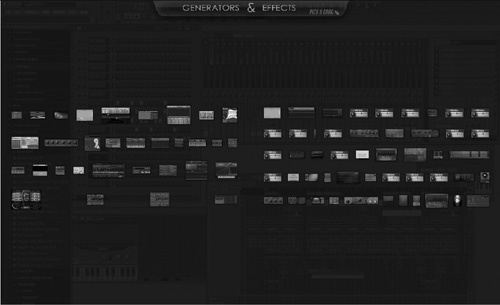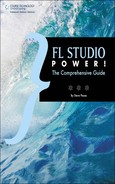Everyone wants to be a producer, but the key is to be able to produce! In today’s market, we need to be ever changing and quick to adapt. Styles change, trends change (although sometimes not soon enough), and even our music changes. Essential to being able to keep up with this whirlwind of musical evolution is having a tool that can seamlessly create these sonic changes. When we think of a great idea, beat, verse, or song, we would like to just open our head and pour it into a CD, shake it up, and voila! Instant music! Although I will someday figure out how to do this, Image Line Software has given us a program that has the tools for taking these ideas from simple thoughts to songs we can instantly hear and restructure any way we see fit—FL Studio!
The abilities of FL Studio far surpass many of the industry-standard names that we are used to seeing, because FL Studio takes a fresh approach to the music-making process. The software allows you to record audio and MIDI using a wealth of plug-ins already included and top-quality effects processors that will place your music well above the demo-CD level. The design is perfect for the musician who demands metronome-like perfection as well as the swing-style musician who likes to have that natural “live” feel.
Even more impressive, the software allows those who enjoy putting together live-performance songs an avenue to express their talent. With its built-in Live feature, you can take portions of your songs, rearrange them to your heart’s content, and end up creating even more impressive compositions in front of an audience. This ends up becoming a fantastic tool for rearranging when you are putting together new music and auditioning different music samples.
FL Studio (originally known as FruityLoops) is a program that places creative control of many types of music in the hands of those who cannot get into million-dollar studios and use the overly complicated array of hardware gear they offer. It is a software-based sequencer that allows you to record any audio source or use the MIDI functions to create new, never-before-heard sounds with a wide range of software synthesizers and effects (see Figure 1.1).
One of the standout features of the program is the Stepsequencer, which is contained inside the Channel window. This is where artists can take a prerecorded sample or software synthesizer and then place it into any channel and select when that sound will play using the buttons on the sequencer. This is great for getting everything exactly on beat because it adheres to the project’s master tempo, or the speed that the music is playing. The Mixer is great for routing sounds you have in the project to specific tracks that you can individually control. This broadens your flexibility for great mixing of volume, panning, and effects processing on each track. The Piano Roll window allows you to take MIDI data and either play notes live or draw them in so you can get your sound just right. You can even lay out preselected chords! The Playlist window is where the different patterns created in the Stepsequencer can be arranged alongside live audio and automation clips, which allow you to control any automatable parameter in FL Studio.
I remember back to the earlier versions of FL Studio, when a friend would demonstrate for me what he had made. It was an interesting setup, and it was not half bad for the time. Interestingly enough, I even found myself occasionally using it on his computer to try to make some little sequenced beats, but never taking anything too seriously. At that point I was DJing in the Gaslamp Quarter of San Diego, so I constantly had my hands on an eclectic blend of music and grooves unheard by many aside from my faithful following. When you listened to something put on vinyl, it towered in quality (arguably) over anything I could make with the program. I saw the basic idea of creation, but I didn’t really know what tools they were using to get the music to breathe and come alive. The latest version has those tools and more.
FL Studio was not always the streamlined program that you see today. It began as a little sequencing program called FruityLoops that was MIDI only. The very first version (1.0) was not even released, but it is still available to the public if anyone wants to see just how far they have come. You can grab it on Image Line’s website in their FL Studio History section. This program was developed in Belgium and created by Didier Dambrin. He holds the lead programmer title and oversees all further development. It was his decision to write the program in Delphi, which is a complicated way to say that it will only work on Windows platforms. Fear not, Mac users—Image Line supports Boot Camp.
FL Studio is all about giving you seemingly limitless options in the way you create music. One thing you will notice when you open the demo projects included in the demo or full version is that not only are the projects different musically, but they also are different in the way they are organized. The program allows users to record and sequence in many different ways. I find that for the singer/songwriter, recording into the Edison (more on this in the “Recording Audio Clips into Edison” section of Chapter 4, “Recording Audio”) is simple, effects and reverb can easily be added, and multiple takes can be layered to create a full sound. On the other hand, the hip-hop producer who wants to get that perfect sound can use the patterns to switch between different beats on the fly to see which works best with the associated lyrics (see Figure 1.2). For the electronic artist, you can loop in different patterns and layer sections all while recording vocals or synths live.

Figure 1.2. In this project, the Stepsequencer has a beat punched in, and the Playlist can be used to go over a section of lyrics to make sure the beat sounds right.
Included in the most basic package of the program is a ton of plug-ins, add-ons, and instruments that put other programs to shame. Many programs are purchased barebones, without any addons, and only allow you to record audio and MIDI. Here’s the problem with that: Without any add-ons, you can’t give your music that wow factor we all seek. Furthermore, if there are no instruments included, when you record MIDI, it will just be nice little squares in the MIDI editor, but no sound will play. (We’ll look more closely at MIDI in Chapter 5, “Recording and Using MIDI.”) To see just how many additional plug-ins are available in FL Studio, press Ctrl+F8 on your keyboard, and it will bring up the Plugin Picker (see Figure 1.3). Bear in mind that some of these are demos, and in some cases, they are entire programs themselves. Although they need to be purchased separately, they are functional minus an occasional audio dropout and the fact that they cannot be saved in a project. The demo plug-ins will say DEMO at the top of their window, and the information on any plug-in (even when it is a demo) can be accessed by pressing F1 when the plug-in is focused.

Figure 1.3. Ctrl+F8 will bring up the Plugin Picker, allowing you to browse FL Studio’s plug-ins and generators.
Just a few notable features of FL Studio include:
Recording audio. Even if all you want to do is play the guitar and record, this program can give you everything you need for a full and complete sound.
Recording and manipulating MIDI. Finally, those master pianists have their work cut out for them! Have you ever thought to yourself, “I can see those notes, but my hands just don’t know where to go”? If you can imagine it, the Piano roll lets you place the notes wherever you like. This can be applied to any instrument loaded into FL Studio.
Looping. Take parts of any number of patterns and place them in any order you wish. This is great for quick reordering when something just isn’t sounding right.
Live mode. The looping feature with touch control! You can assign a MIDI controller to skip to different parts of your composition.
MIDI Machine control. FL Studio has added MIDI Machine control so that you can control parameters in FL Studio using your controller or control surface. This means if you have a keyboard with faders or a control surface, you can link your volume control, panning, filters, and so on inside FL Studio to a fader on your external device, giving you that hands-on feel of a studio.
Time stretching. This is a big one for those remixer artists out there. Many times you can find yourself cutting and pasting for hours, trying to get a song to match a beat you have created. Now you can just click and drag, and the selection will adhere to the tempo you select.
Multiple routing. In FL Studio you can send in up to 99 tracks of audio, although most soundcards will not be able to do this. You can send out different mixes simultaneously to hear one version of a song in one set of speakers and a completely different version in another set.
Effects routing. I must praise the Image Line folks for setting up the ability to move plug-in effects ordering around. A simple click on your effect gives you the ability to reorder your effects.
Customizable interface. Don’t like where something is? You can move it! Practically the entire GUI (graphical user interface) can be moved around to suit your needs or computer screen area.
This program is for nearly anyone! If you are recording simple riffs, composing complicated pieces using MIDI, making the latest chart-topping beats, or even scoring to a movie, it can be done right here with this program. Any style of music that can be created can be catered to, and I have not found any limitations even within my own personal music preferences. I hold spanning interests in hip-hop, house/electronic, and acoustic guitar. I find that with the power of FL Studio, I can take a hip-hop beat, run it a few times, set it to loop, and add guitar. Speed it up, and all of a sudden I’m working with a breakbeat house track! Many artists have found FL Studio to be a great building program to create their masterpieces.
What makes the program so useful is its ease of use and how quickly you can create music and mold it into a professional-sounding piece. With the ability of a workflow like this, there is no limit to what you can accomplish. There is nothing worse than getting to a spot where the creative juices are flowing and then reaching a lull in productivity because using the program is cumbersome. Slowing you down in your creation, in my opinion, is the worst thing that can happen. Granted, there are those of us out there who do not run out of ideas, but for those people, now you can write twice as many songs, and that means twice as many Grammys!
So now the fun part begins: how, what, where, when, and why? The next chapter explains the setup of the program and what you need to look for when putting together your workstation. I will explain the system requirements and things you will need and even provide some suggestions on things you will want to have when considering your studio. Keep in mind the following questions when looking through the next chapter: What pertains to me? Do I need this? Will this make my life easier when recording and creating?

